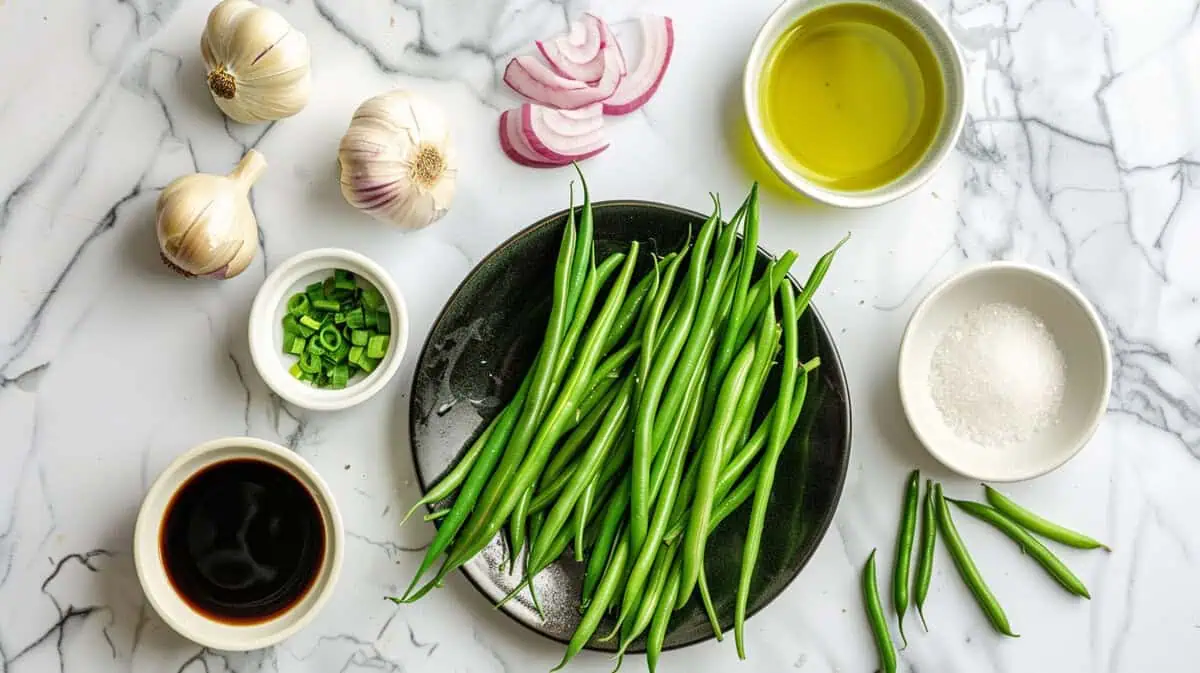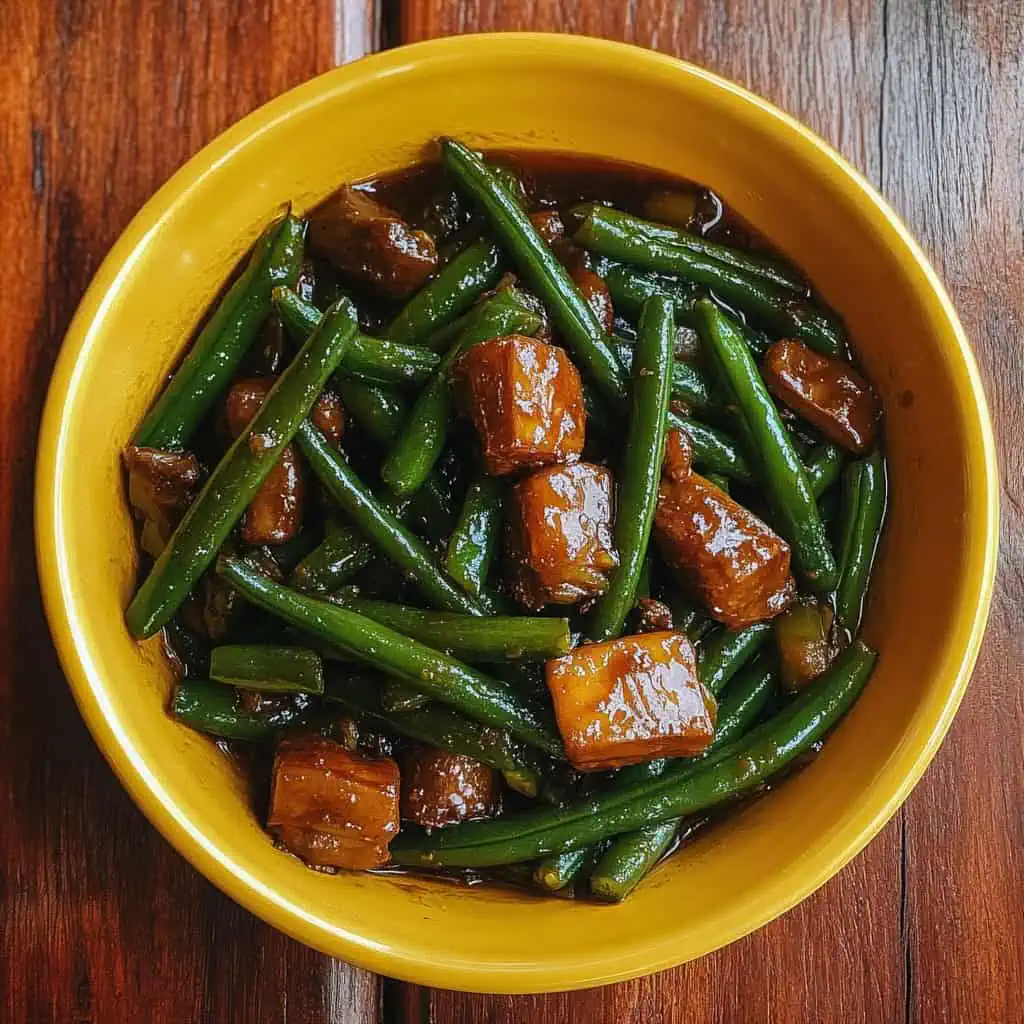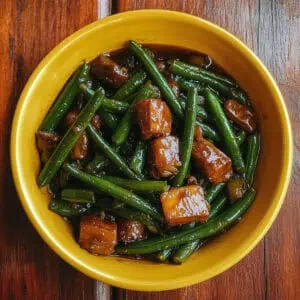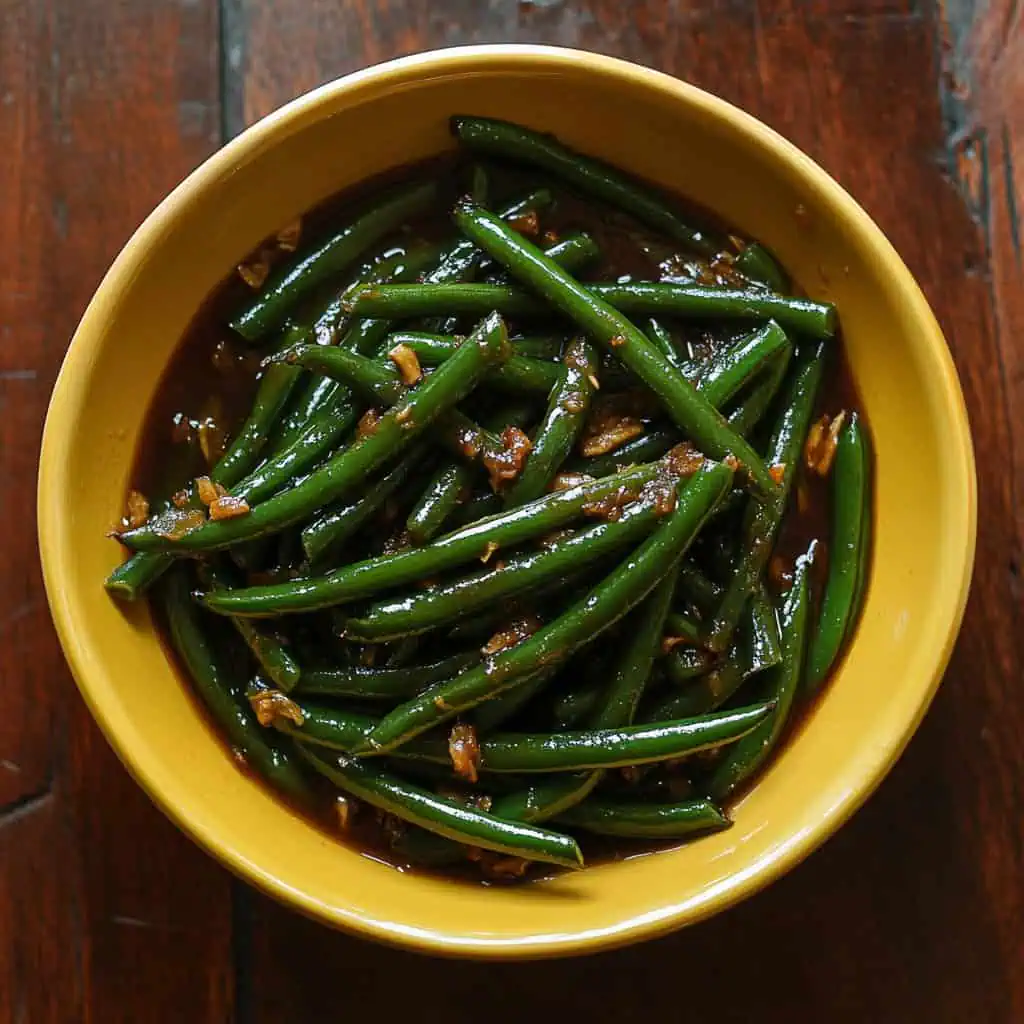I used to walk right past long green beans at the grocery store. They looked too tough and chewy for my liking. Then my neighbor Ate Cynthia invited me over for dinner and served this incredible dish. The beans were tender, flavorful, and nothing like what I expected.
She taught me her secret: the perfect balance of soy sauce, oyster sauce, and just the right cooking time. Now I make this ginisang batong whenever I want to because it's honestly that good. The beans transform into something completely different when you sauté them with garlic and onions . They become sweet, savory, and addictively delicious.
Plus, this whole dish comes together in just 15 minutes, making it perfect for those nights when you want something healthy but don't have much time to cook.

Why You'll Love This Recipe
This Filipino comfort food brings together tender-crisp green beans with aromatic garlic and onions in a savory umami-packed sauce. It's incredibly versatile - serve it as a healthy side dish or add your favorite protein to make it a complete meal.
The best part? This nutritious dish comes together in just 15 minutes using simple pantry ingredients, making it perfect for busy weeknights when you want something wholesome and delicious on the table fast.
Jump to:
Ingredients
- 1 pound long green beans, ends trimmed and cut into 1-inch pieces
- 1 tablespoon garlic, minced
- ½ cup red onion, chopped
- 2 tablespoons cooking oil
- 1 ½ tablespoons soy sauce
- 1 ½ tablespoons oyster sauce
- ½ tablespoon white vinegar
- ½ teaspoon white sugar
- 1 tablespoon water

I chose these ingredients because they create the perfect balance of flavors that make Filipino vegetables so irresistible. The garlic and onion form our aromatic base, while the combination of soy sauce and oyster sauce provides that rich umami depth.
The touch of vinegar adds brightness to cut through the richness, and a hint of sugar balances everything beautifully. Together, they transform simple green beans into something truly special.
Equipment
- Large skillet or wok - The wide surface area allows the beans to cook evenly without overcrowding, ensuring they stay crisp-tender rather than steaming.
- Sharp knife - Essential for cleanly trimming bean ends and chopping vegetables uniformly for even cooking.
- Cutting board - Provides a stable surface for safe and efficient prep work.
- Wooden spoon or spatula - Perfect for stirring without scratching your pan and helps distribute the sauce evenly.

How To Make
- Heat the cooking oil in your large skillet over medium-high heat until it shimmers slightly. Add the minced garlic and sauté for about 30 seconds until it becomes fragrant and lightly golden - don't let it burn or it will taste bitter.
- Toss in the chopped red onions and continue sautéing for 1-2 minutes until they turn translucent and soften. The onions should still have a slight bite to them.
- Add the green beans to the pan and stir everything together. Sauté for exactly 2 minutes while stirring frequently to ensure even cooking. The beans should still be bright green and crisp.
- Pour in the soy sauce, vinegar, water, and sugar all at once. Stir everything together until the sauce coats all the beans evenly. The liquid will sizzle and create aromatic steam.
- Continue cooking for another 2 minutes, stirring constantly to prevent sticking. The beans should start to become tender but still have some crunch.
- Add the oyster sauce and stir until it's completely incorporated with the other ingredients. The sauce should now coat everything in a glossy, savory glaze.
- Cook for 6-8 more minutes, stirring frequently, until the green beans reach your desired tenderness. They should be tender-crisp, not mushy. Taste and adjust seasoning if needed.
- Remove from heat immediately and transfer to your serving dish. Serve hot alongside steamed white rice.

Tips from Lola's Kitchen
- Always trim bean ends properly - those tough tips can ruin the texture of your dish
- Cut beans uniformly so they cook at the same rate and look more professional
- Don't overcrowd the pan - cook in batches if needed to maintain that perfect sear
- Keep the heat at medium-high throughout cooking to get that lovely caramelization
- Taste your beans at the 8-minute mark - they should have a slight bite, not be mushy
- If your beans are particularly thick, add an extra tablespoon of water and cook a bit longer
- Fresh garlic makes all the difference - don't use the pre-minced stuff from a jar
Substitutions
- Long green beans: Regular green beans work fine, just reduce cooking time by 2-3 minutes
- Red onion: Yellow or white onions are perfectly acceptable substitutes
- Oyster sauce: Use mushroom sauce for vegetarian version or extra soy sauce in a pinch
- White sugar: Brown sugar or palm sugar add deeper flavor
- Cooking oil: Avocado oil or vegetable oil work just as well as any neutral oil
- White vinegar: Rice vinegar or cane vinegar provide similar acidity
Troubleshooting
- Beans too tough: Add 2 tablespoons water, cover, and steam for 2-3 minutes
- Too salty: Add a pinch of sugar and a splash of water to balance flavors
- Sauce too thin: Cook uncovered for extra 2-3 minutes to reduce liquid
- Garlic burned: Start over - burned garlic will make the whole dish bitter
- Beans overcooked and mushy: Next time, reduce cooking time and check doneness earlier
- Not enough flavor: Add extra oyster sauce or a dash more soy sauce at the end
Storage & Reheating
- Refrigerator: Store covered for up to 3 days - beans will soften slightly but still taste great
- Freezer: Not recommended as beans become mushy when thawed
- Reheating: Use medium heat in a skillet for 2-3 minutes, stirring gently to avoid breaking beans
- Microwave reheating: 30-second intervals, stirring between, until heated through
- Best served: Fresh and hot, but leftovers make excellent additions to fried rice

FAQ
Can I add meat to this dish?
Absolutely! Sauté thin pork strips or ground meat before adding garlic, then proceed with recipe.
How do I know when beans are perfectly cooked?
They should bend easily but still have a slight snap when bitten - tender-crisp is the goal.
Can I make this ahead of time?
It's best served fresh, but you can prep ingredients hours ahead and cook just before serving.
Why do my beans turn brown?
Either the heat is too high or they're overcooked - medium-high heat and proper timing prevent this.
Is this dish naturally vegetarian?
Yes, if you use mushroom sauce instead of oyster sauce, it becomes completely vegetarian-friendly.
Can I use frozen green beans?
Fresh is best, but if using frozen, don't thaw first and reduce cooking time by half.
What other vegetables work with this method?
Try snow peas, snap peas, or even broccoli using the same technique and timing adjustments.
Related
Looking for other recipes like this? Try these:

Ginisang Batong (Sautéed Long Green Beans)
Ingredients
- 1 pound long green beans ends trimmed and cut into 1-inch pieces
- 1 tablespoon garlic minced
- ½ cup red onion chopped
- 2 tablespoons cooking oil
- 1 ½ tablespoons soy sauce
- 1 ½ tablespoons oyster sauce
- ½ tablespoon white vinegar
- ½ teaspoon white sugar
- 1 tablespoon water
Instructions
- Heat the cooking oil in your large skillet over medium-high heat until it shimmers slightly. Add the minced garlic and sauté for about 30 seconds until it becomes fragrant and lightly golden - don't let it burn or it will taste bitter.
- Toss in the chopped red onions and continue sautéing for 1-2 minutes until they turn translucent and soften. The onions should still have a slight bite to them.
- Add the green beans to the pan and stir everything together. Sauté for exactly 2 minutes while stirring frequently to ensure even cooking. The beans should still be bright green and crisp.
- Pour in the soy sauce, vinegar, water, and sugar all at once. Stir everything together until the sauce coats all the beans evenly. The liquid will sizzle and create aromatic steam.
- Continue cooking for another 2 minutes, stirring constantly to prevent sticking. The beans should start to become tender but still have some crunch.
- Add the oyster sauce and stir until it's completely incorporated with the other ingredients. The sauce should now coat everything in a glossy, savory glaze.
- Cook for 6-8 more minutes, stirring frequently, until the green beans reach your desired tenderness. They should be tender-crisp, not mushy. Taste and adjust seasoning if needed.
- Remove from heat immediately and transfer to your serving dish. Serve hot alongside steamed white rice.
Tips from Lola's Kitchen
- Always trim bean ends properly - those tough tips can ruin the texture of your dish
- Cut beans uniformly so they cook at the same rate and look more professional
- Don't overcrowd the pan - cook in batches if needed to maintain that perfect sear
- Keep the heat at medium-high throughout cooking to get that lovely caramelization
- Taste your beans at the 8-minute mark - they should have a slight bite, not be mushy
- If your beans are particularly thick, add an extra tablespoon of water and cook a bit longer
- Fresh garlic makes all the difference - don't use the pre-minced stuff from a jar
The Story Behind Ginisang Batong
Ginisang batong has been a staple in Filipino kitchens for generations, born from the practical need to make simple vegetables taste extraordinary. The word "ginisa" means "sautéed" in Filipino, while "batong" refers to the long green beans that are the star of this dish. This cooking method reflects the resourceful nature of Filipino home cooking, where families learned to create flavorful meals using whatever vegetables were available in their gardens or local markets.
The technique of sautéing vegetables with garlic, onions, and soy-based sauces came from centuries of culinary influence in the Philippines. Chinese traders introduced soy sauce and the stir-frying method, while Spanish colonization brought the practice of using sofrito - the aromatic base of garlic and onions. Filipino cooks brilliantly combined these influences with their own indigenous ingredients and cooking wisdom to create dishes like ginisang batong.
What makes this dish truly Filipino is how it transforms humble long green beans into something special through the perfect balance of savory, sweet, and tangy flavors. The addition of vinegar - a crucial ingredient in Filipino cuisine - brightens the dish and cuts through the richness of the soy and oyster sauces. This balance reflects the Filipino palate's love for complex flavors that complement rather than overpower the main ingredient.
Today, ginisang batong remains a beloved comfort food across Filipino households worldwide. It represents the beauty of simple cooking - using basic ingredients and traditional techniques to create something deeply satisfying. Whether served as a side dish with rice or enhanced with meat for a complete meal, this recipe continues to bring families together around the dinner table, just as it has for countless generations.










Comments
No Comments